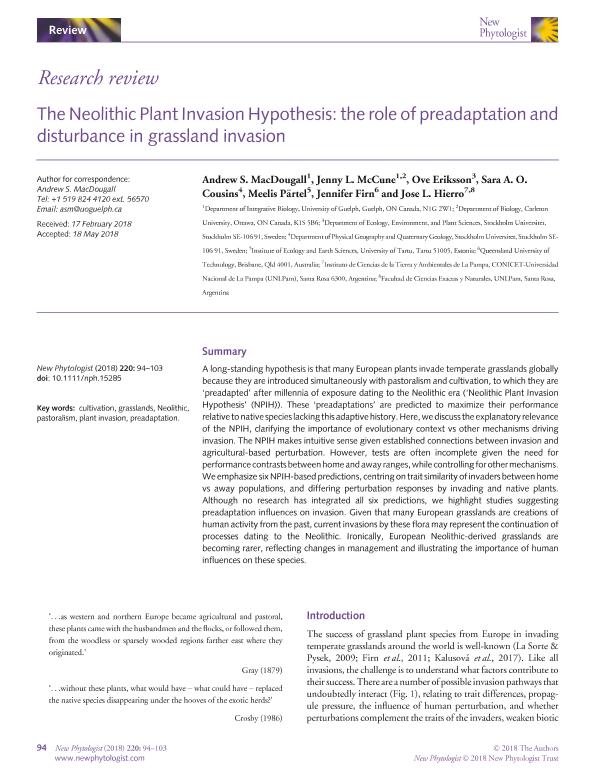Mostrar el registro sencillo del ítem
dc.contributor.author
MacDougall, Andrew S.
dc.contributor.author
McCune, Jenny L.
dc.contributor.author
Eriksson, Ove
dc.contributor.author
Cousins, Sara A. O.
dc.contributor.author
Pärtel, Meelis
dc.contributor.author
Firn, Jennifer

dc.contributor.author
Hierro, Jose Luis

dc.date.available
2019-08-12T18:39:35Z
dc.date.issued
2018-10
dc.identifier.citation
MacDougall, Andrew S.; McCune, Jenny L.; Eriksson, Ove; Cousins, Sara A. O.; Pärtel, Meelis; et al.; The Neolithic Plant Invasion Hypothesis: the role of preadaptation and disturbance in grassland invasion; Wiley Blackwell Publishing, Inc; New Phytologist; 220; 1; 10-2018; 94-103
dc.identifier.issn
0028-646X
dc.identifier.uri
http://hdl.handle.net/11336/81488
dc.description.abstract
A long-standing hypothesis is that many European plants invade temperate grasslands globally because they are introduced simultaneously with pastoralism and cultivation, to which they are ‘preadapted’ after millennia of exposure dating to the Neolithic era (‘Neolithic Plant Invasion Hypothesis’ (NPIH)). These ‘preadaptations’ are predicted to maximize their performance relative to native species lacking this adaptive history. Here, we discuss the explanatory relevance of the NPIH, clarifying the importance of evolutionary context vs other mechanisms driving invasion. The NPIH makes intuitive sense given established connections between invasion and agricultural-based perturbation. However, tests are often incomplete given the need for performance contrasts between home and away ranges, while controlling for other mechanisms. We emphasize six NPIH-based predictions, centring on trait similarity of invaders between home vs away populations, and differing perturbation responses by invading and native plants. Although no research has integrated all six predictions, we highlight studies suggesting preadaptation influences on invasion. Given that many European grasslands are creations of human activity from the past, current invasions by these flora may represent the continuation of processes dating to the Neolithic. Ironically, European Neolithic-derived grasslands are becoming rarer, reflecting changes in management and illustrating the importance of human influences on these species.
dc.format
application/pdf
dc.language.iso
eng
dc.publisher
Wiley Blackwell Publishing, Inc

dc.rights
info:eu-repo/semantics/openAccess
dc.rights.uri
https://creativecommons.org/licenses/by-nc-sa/2.5/ar/
dc.subject
Cultivation
dc.subject
Grasslands
dc.subject
Neolithic
dc.subject
Pastoralism
dc.subject
Plant Invasion
dc.subject
Preadaptation
dc.subject.classification
Ecología

dc.subject.classification
Ciencias Biológicas

dc.subject.classification
CIENCIAS NATURALES Y EXACTAS

dc.title
The Neolithic Plant Invasion Hypothesis: the role of preadaptation and disturbance in grassland invasion
dc.type
info:eu-repo/semantics/article
dc.type
info:ar-repo/semantics/artículo
dc.type
info:eu-repo/semantics/publishedVersion
dc.date.updated
2019-08-09T14:31:48Z
dc.journal.volume
220
dc.journal.number
1
dc.journal.pagination
94-103
dc.journal.pais
Reino Unido

dc.journal.ciudad
Londres
dc.description.fil
Fil: MacDougall, Andrew S.. University of Guelph; Canadá
dc.description.fil
Fil: McCune, Jenny L.. University of Guelph; Canadá. Carleton University; Canadá
dc.description.fil
Fil: Eriksson, Ove. Stockholm Universitet; Suecia
dc.description.fil
Fil: Cousins, Sara A. O.. Stockholm Universitet; Suecia
dc.description.fil
Fil: Pärtel, Meelis. University Of Tartu.; Estonia
dc.description.fil
Fil: Firn, Jennifer. Queensland University of Technology; Australia
dc.description.fil
Fil: Hierro, Jose Luis. Consejo Nacional de Investigaciones Científicas y Técnicas. Instituto de Ciencias de la Tierra y Ambientales de La Pampa. Universidad Nacional de La Pampa. Facultad de Ciencias Exactas y Naturales. Instituto de Ciencias de la Tierra y Ambientales de La Pampa; Argentina. Universidad Nacional de La Pampa. Facultad de Ciencias Exactas y Naturales; Argentina
dc.journal.title
New Phytologist

dc.relation.alternativeid
info:eu-repo/semantics/altIdentifier/doi/http://dx.doi.org/10.1111/nph.15285
dc.relation.alternativeid
info:eu-repo/semantics/altIdentifier/url/https://nph.onlinelibrary.wiley.com/doi/abs/10.1111/nph.15285
Archivos asociados
